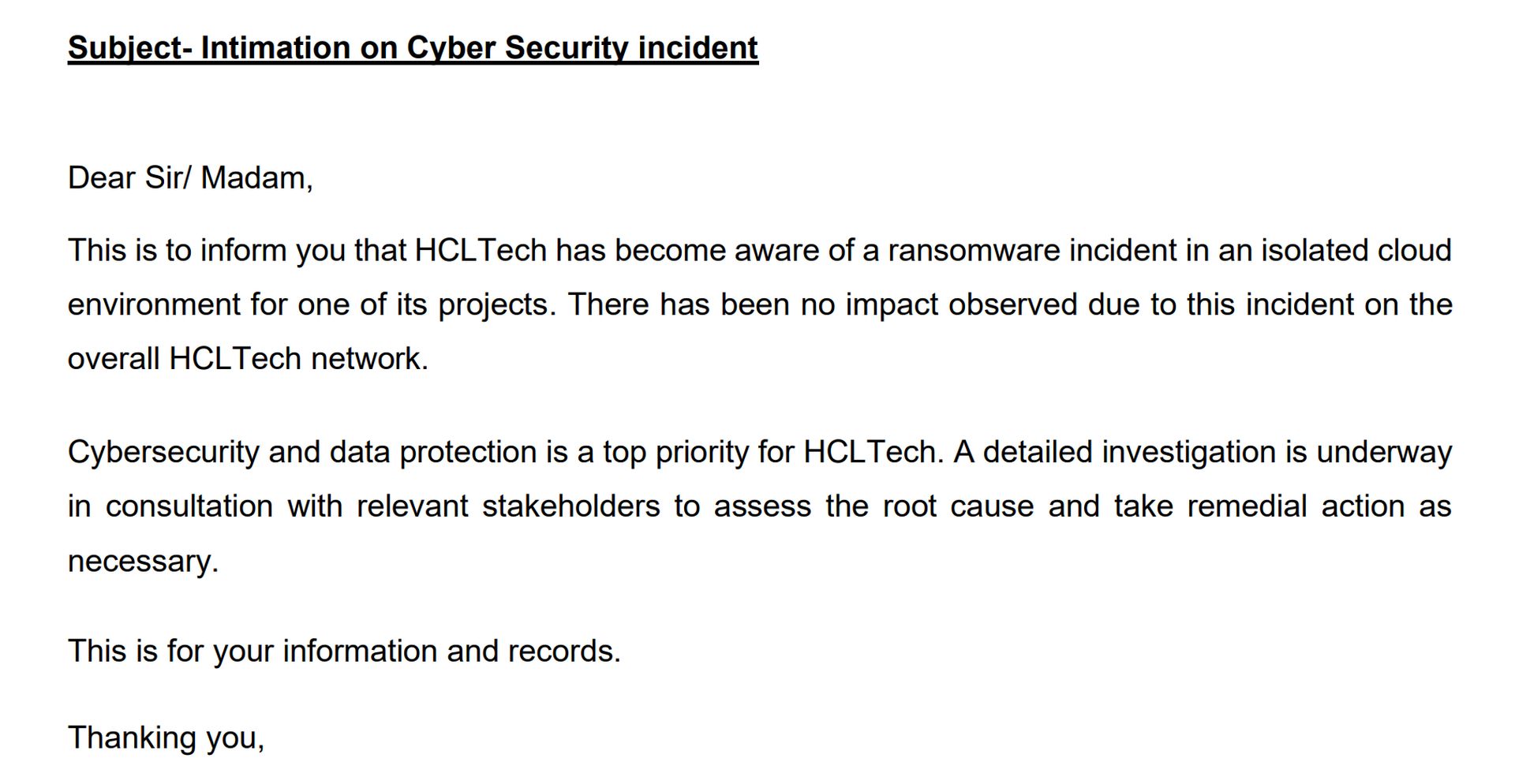HCL Technologies, a stalwart in the IT sector, recently grappled with a ransomware attack targeting a specific project in its isolated cloud environment.
Prior to the ransomware incident, HCL Technologies achieved a significant milestone by crossing a market capitalization of Rs 4 trillion ($48.1b), solidifying its position as the 13th largest listed company on the Indian stock exchanges. This situation seems to have attracted the attention of hackers
Here is what you need to know about the HCL Technologies ransomware attack
HCL Technologies recently faced a ransomware attack targeting one project within an isolated cloud environment. The incident was revealed through a regulatory filing in which the company acknowledged its awareness of the ransomware occurrence. HCL Technologies emphasized that the impact of this incident had been confined to the specific project and did not extend to the overall HCLTech network.

In response to the HCL Technologies ransomware attack, the firm has initiated a comprehensive investigation to understand the root cause of the ransomware incident. The company is working in consultation with relevant stakeholders to assess the situation thoroughly. The primary goal of this investigation is to identify the factors that led to the security breach and to take necessary remedial actions to mitigate any potential damage.
The isolated cloud environment affected by the HCL Technologies ransomware attack is under scrutiny as part of the ongoing investigation.
It’s noteworthy that HCL Technologies prioritizes cybersecurity and data protection, underscoring its commitment to safeguarding digital assets. The proactive approach taken by the company in response to the HCL Technologies ransomware attack reflects the industry-wide recognition of the critical importance of cybersecurity in the ever-evolving landscape of the IT sector.
Despite this security challenge, the data does not indicate any observable impact on HCL Technologies’ overall network. This underscores the effectiveness of the company’s security measures in isolating and containing the incident. The proactive stance, detailed investigation, and commitment to remedial action suggest that HCL Technologies is taking the necessary steps to address and rectify the situation.
Despite the HCL Technologies ransomware attack, the firm’s shares were trading positively at Rs 1,493.5 apiece on the BSE at 10:15 am on the day of the incident, showcasing a resilient market response. However, as the investigation unfolds, stakeholders, including clients and investors, will likely be keenly interested in understanding the incident’s specific details and the measures HCL Technologies took to reinforce its cybersecurity infrastructure.
Ransomware attacks are trending
The HCL Technologies ransomware attack came just after the Insomniac hack. It was led by the Rhysida hacker group and exposed sensitive data, including details about the upcoming Wolverine PS5 game and other games, until 2030, after Sony refused to pay a 50 Bitcoins ransom. But how were these giant companies hacked? Let’s take a closer look.

Ransomware attacks are on the rise globally, targeting entities across industries and sectors. The frequency of these incidents is a cause for concern, signaling a lucrative venture for cybercriminals seeking financial gains through extortion.
We have to admit that cybercriminals are becoming increasingly sophisticated in their tactics, employing advanced techniques to breach even well-fortified digital defenses. Though contained, the HCL Technologies ransomware attack underscores the adaptability and agility of these cyber threats. However, they do not need to choose sci-fi hacker tactics always. For example, the Insomniac hackers revealed that they chose them because it is easy. The group claimed breaching the system just took 20–25 minutes.
“Yes, we knew who we were attacking. We knew that developers making games like this would be an easy target.”
Social engineering remains a key component of ransomware attacks. Cybercriminals often target the human element as the entry point for their malicious activities, whether through phishing emails or exploiting human vulnerabilities.
So, what to do? Besides your IT team’s great effort, individuals and organizations should prioritize regular software updates to patch vulnerabilities. Strong, unique passwords and multi-factor authentication add layers of protection to accounts. Vigilance in email interactions, such as avoiding suspicious links, is crucial. Regular data backups and the installation of reputable antivirus software provide defenses against ransomware attacks. Limiting user privileges and fostering cybersecurity education further strengthen resilience.
Securing Wi-Fi networks with strong passwords and encryption, implementing network segmentation, and conducting regular security audits are essential defensive strategies. Developing an incident response plan and collaborating with cybersecurity communities contribute to effective crisis management. Monitoring system logs for unusual activities aids in early threat detection. Staying informed about evolving cybersecurity trends and best practices is fundamental for adapting to emerging threats.
Adopting these measures collectively establishes a proactive and robust cybersecurity posture, reducing vulnerability to cyber threats.
- SEO Powered Content & PR Distribution. Get Amplified Today.
- PlatoData.Network Vertical Generative Ai. Empower Yourself. Access Here.
- PlatoAiStream. Web3 Intelligence. Knowledge Amplified. Access Here.
- PlatoESG. Carbon, CleanTech, Energy, Environment, Solar, Waste Management. Access Here.
- PlatoHealth. Biotech and Clinical Trials Intelligence. Access Here.
- Source: https://dataconomy.com/2023/12/22/hcl-technologies-ransomware-attack/
- :has
- :is
- :not
- 1
- 10
- 15%
- 1b
- 2030
- 50
- 7
- a
- About
- Accounts
- achieved
- acknowledged
- across
- Action
- actions
- activities
- add
- address
- admit
- advanced
- affected
- After
- against
- aids
- always
- am
- an
- and
- antivirus
- Antivirus Software
- any
- approach
- ARE
- AS
- assess
- Assets
- At
- attack
- Attacking
- Attacks
- attention
- attracted
- audits
- Authentication
- avoiding
- awareness
- backups
- BE
- because
- becoming
- been
- besides
- BEST
- best practices
- Bitcoins
- breach
- but
- by
- came
- capitalization
- Cause
- challenge
- Choose
- chose
- claimed
- clients
- closer
- Cloud
- collaborating
- collectively
- commitment
- Communities
- Companies
- company
- Company’s
- component
- comprehensive
- Concern
- conducting
- consultation
- contained
- contribute
- crisis
- critical
- crossing
- crucial
- cyber
- cybercriminals
- Cybersecurity
- damage
- data
- data protection
- day
- defensive
- detailed
- details
- Detection
- developers
- developing
- DID
- digital
- Digital Assets
- do
- does
- Early
- easy
- Education
- Effective
- effectiveness
- effort
- element
- emails
- emerging
- emphasized
- employing
- encryption
- Engineering
- entities
- entry
- Environment
- essential
- establishes
- Ether (ETH)
- Even
- evolving
- example
- Exchanges
- explained
- exposed
- extend
- extortion
- faced
- factors
- financial
- Firm
- following
- For
- fostering
- Frequency
- fundamental
- further
- Gains
- game
- Games
- giant
- Globally
- goal
- great
- Group
- hacked
- hacker
- hackers
- had
- Have
- High
- How
- However
- HTTPS
- human
- Human Element
- identify
- Impact
- implementing
- importance
- in
- incident
- incident response
- incidents
- Including
- increasingly
- Indian
- indicate
- individuals
- industries
- informed
- Infrastructure
- initiated
- installation
- interactions
- interested
- investigation
- Investors
- isolated
- IT
- IT sector
- ITS
- jpg
- just
- Key
- Know
- landscape
- largest
- layers
- LEARN
- Led
- like
- likely
- links
- Listed
- Look
- lucrative
- Making
- management
- Market
- Market Capitalization
- max-width
- measures
- milestone
- minutes
- Mitigate
- monitoring
- multi-factor authentication
- necessary
- Need
- network
- networks
- noteworthy
- occurrence
- of
- often
- on
- ONE
- ongoing
- or
- organizations
- Other
- overall
- part
- Passwords
- Patch
- Pay
- phishing
- plan
- plato
- Plato Data Intelligence
- PlatoData
- Point
- position
- positively
- potential
- practices
- primary
- Prioritize
- prioritizes
- privileges
- Proactive
- project
- protection
- provide
- PS5
- Ransom
- ransomware
- Ransomware Attack
- Ransomware Attacks
- recent
- recently
- recognition
- reducing
- reflects
- regular
- reinforce
- relevant
- remains
- reputable
- resilience
- resilient
- response
- Revealed
- Rise
- robust
- root
- safeguarding
- sci-fi
- scrutiny
- sector
- Sectors
- security
- Security audits
- Security Measures
- seeking
- seems
- segmentation
- sensitive
- Shares
- should
- showcasing
- significant
- situation
- Software
- solidifying
- Sony
- sophisticated
- specific
- stakeholders
- stance
- staying
- Steps
- stock
- stock exchanges
- strategies
- Strengthen
- strong
- such
- suggest
- suspicious
- swiftly
- system
- tactics
- Take
- taken
- taking
- Target
- targeting
- techniques
- Technologies
- that
- The
- their
- Them
- These
- they
- this
- thoroughly
- though?
- threat
- threat detection
- threats
- Through
- to
- took
- Trading
- Trillion
- under
- underscores
- understand
- understanding
- unique
- unravel
- until
- unusual
- unveiled
- upcoming
- Updates
- User
- venture
- vigilance
- Vulnerabilities
- vulnerability
- Wake
- was
- we
- were
- What
- whether
- which
- WHO
- Wi-fi
- will
- with
- within
- Wolverine
- working
- would
- you
- Your
- zephyrnet












